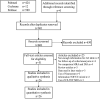MRA versus DSA for follow-up of coiled intracranial aneurysms: a meta-analysis
- PMID: 24008171
- PMCID: PMC7966263
- DOI: 10.3174/ajnr.A3700
MRA versus DSA for follow-up of coiled intracranial aneurysms: a meta-analysis
Abstract
MR angiography is proposed as a safer and less expensive alternative to the reference standard, DSA, in the follow-up of intracranial aneurysms treated with endovascular coil occlusion. We performed a systematic review and meta-analysis to evaluate the accuracy of TOF-MRA and contrast-enhanced MRA in detecting residual flow in the follow-up of coiled intracranial aneurysms. Literature was reviewed through the PubMed, Cochrane, and EMBASE data bases. In comparison with DSA, the sensitivity of TOF-MRA was 86% (95% CI: 82-89%), with a specificity of 84% (95% CI: 81-88%), for the detection of any recurrent flow. For contrast-enhanced MRA, the sensitivity and specificity were 86% (95% CI: 82-89%) and 89% (95% CI: 85-92%), respectively. Both TOF-MRA and contrast-enhanced MRA are shown to be highly accurate for detection of any recanalization in intracranial aneurysms treated with endovascular coil occlusion.
© 2014 by American Journal of Neuroradiology.
Figures



Similar articles
-
MR angiography in the follow-up of intracranial aneurysms treated with Guglielmi detachable coils: systematic review and meta-analysis.Neuroradiology. 2007 Sep;49(9):703-13. doi: 10.1007/s00234-007-0266-5. Epub 2007 Jul 24. Neuroradiology. 2007. PMID: 17646977
-
Usefulness of non-contrast-enhanced ultrashort echo time magnetic resonance angiography for assessing cerebral aneurysms after woven endobridge device treatment.J Stroke Cerebrovasc Dis. 2025 Aug;34(8):108361. doi: 10.1016/j.jstrokecerebrovasdis.2025.108361. Epub 2025 May 27. J Stroke Cerebrovasc Dis. 2025. PMID: 40441325
-
Usefulness of silent magnetic resonance angiography for intracranial aneurysms treated with a flow re-direction endoluminal device.Interv Neuroradiol. 2025 Aug;31(4):517-525. doi: 10.1177/15910199231174546. Epub 2023 May 7. Interv Neuroradiol. 2025. PMID: 37151078 Free PMC article.
-
Methods and time schedule for follow-up of intracranial aneurysms treated with endovascular embolization: a systematic review.Neurol Neurochir Pol. 2011 Sep-Oct;45(5):421-30. doi: 10.1016/s0028-3843(14)60309-1. Neurol Neurochir Pol. 2011. PMID: 22127936
-
Duplex ultrasound for diagnosing symptomatic carotid stenosis in the extracranial segments.Cochrane Database Syst Rev. 2022 Jul 11;7(7):CD013172. doi: 10.1002/14651858.CD013172.pub2. Cochrane Database Syst Rev. 2022. PMID: 35815652 Free PMC article.
Cited by
-
Endovascular treatment of challenging aneurysms with FRED Jr flow diverter stents: a single-center experience.Jpn J Radiol. 2023 Mar;41(3):322-334. doi: 10.1007/s11604-022-01354-2. Epub 2022 Oct 31. Jpn J Radiol. 2023. PMID: 36315360 Free PMC article.
-
Intensity of arterial structure acquired by Silent MRA estimates cerebral blood flow.Insights Imaging. 2021 Dec 11;12(1):185. doi: 10.1186/s13244-021-01132-0. Insights Imaging. 2021. PMID: 34894298 Free PMC article.
-
The clinical value of ceMRA versus DSA for follow-up of intracranial aneurysms treated by coil embolization: an assessment of occlusion classifications and impact on treatment decisions.Eur Radiol. 2021 Jun;31(6):4104-4113. doi: 10.1007/s00330-020-07492-3. Epub 2020 Nov 21. Eur Radiol. 2021. PMID: 33221944
-
Noninvasive Angiographic Results of Clipped or Coiled Intracranial Aneurysms: An Inter- and Intraobserver Reliability Study.AJNR Am J Neuroradiol. 2021 Sep;42(9):1615-1620. doi: 10.3174/ajnr.A7236. Epub 2021 Jul 29. AJNR Am J Neuroradiol. 2021. PMID: 34326106 Free PMC article.
-
Inter- and Intrarater Agreement on the Outcome of Endovascular Treatment of Aneurysms Using MRA.AJNR Am J Neuroradiol. 2016 May;37(5):879-84. doi: 10.3174/ajnr.A4609. Epub 2015 Dec 10. AJNR Am J Neuroradiol. 2016. PMID: 26659336 Free PMC article.
References
-
- Rinkel GJ, Djibuti M, Algra A, et al. . Prevalence and risk of rupture of intracranial aneurysms: a systematic review. Stroke 1998;29:251–56 - PubMed
-
- Vlak MH, Algra A, Brandenburg R, et al. . Prevalence of unruptured intracranial aneurysms, with emphasis on sex, age, comorbidity, country, and time period: a systematic review and meta-analysis. Lancet Neurol 2011;10:626–36 - PubMed
-
- Molyneux A, Kerr R, Stratton I, et al. . International Subarachnoid Aneurysm Trial (ISAT) of neurosurgical clipping versus endovascular coiling in 2143 patients with ruptured intracranial aneurysms: a randomised trial. Lancet 2002;360:1267–74 - PubMed
-
- Naggara ON, White PM, Guilbert F, et al. . Endovascular treatment of intracranial unruptured aneurysms: systematic review and meta-analysis of the literature on safety and efficacy. Radiology 2010;256:887–97 - PubMed
-
- Dawkins AA, Evans AL, Wattam J, et al. . Complications of cerebral angiography: a prospective analysis of 2,924 consecutive procedures. Neuroradiology 2007;49:753–59 - PubMed
Publication types
MeSH terms
LinkOut - more resources
Full Text Sources
Other Literature Sources
Medical
